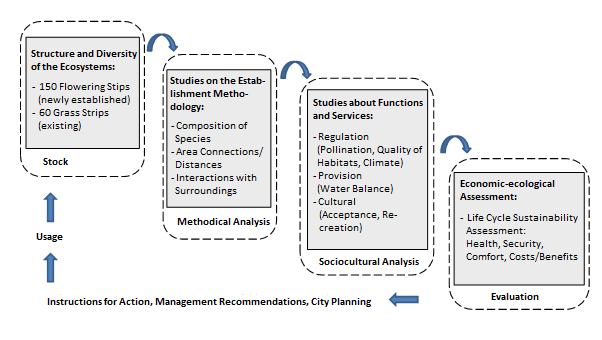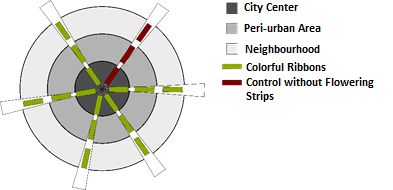Work package 1: Installation of close to nature flower areas under field trial
To enhance the ecological functionality of cities in times of climate change and to promote the transposition of pollinators and other useful animals from the vicinity to the city center, new flowering areas in lawns at verges of traffic axes will be installed (see figure 1: Project concept - promotion of the ecological functionality of urban green areas).

The most suitable axes in Munich are the Ingolstädter Straße from the northern Leopoldstraße to the protected area Panzerwiese, the Lerchenauer Straße, the Arnulfstraße, the Agnes-Bernauer-Straße, the Gotthardstraße, the Fürstenrieder Straße, the Rosenheimer Straße and the Freisinger Landstraße. The so far seeded species-poor grass mixtures will be replaced at five of these arterial roads by insect friendly, close to nature flowering mixtures with different wild flower covers. The flowering areas will connect the city center with the vicinity by the semi-urban areas and will create a "Colorful Ribbon" following traffic axes with decreasing sealing and increasing vegetation cover (figure 2).

Within each city area the colorful ribbons will extend over a maximum length of 1200 m and a minimal distance of 1500 m. Therefore there is a minimal length of 6700 m necessary for the traffic axes. To enable mitigation and transposition of pollinators such as wild bees and other useful animals, up to 10 flowering areas will be installed at each "Colorful Ribbon" (figure 3). The flowering areas of each city area will be installed in the greened verges in exponentially increasing distances of 7, 20, 55, 150, 400, 400, 150, 55, 20 and 7 m. Thus it will be possible to understand the direction of the mitigation as well as the optimal distances between the flowering areas by capture-recapture, tint bowls and nesting aids.

Because the interactions of the flowering areas with their surrounding environment are a main focus of our project, the other functions of the experimental plots (amount of green, sealing), dispersal barriers for pollinators (bridges, subways) and the distance to the vicinity will be analysed.
For each flowering area three adjacent to one another plots of an area of 2 m x 3 m will be installed. The installation of these flowering areas will be done with standardized species mixtures with a high attractivity for pollinators and other useful animals. They conform commercial available "mixtures for traffic islands" with annual and perennial wild plants of local origin. Especially attractive species for pollinators are Centaurea cyanus, Knautia arvensis and Teucrium chamaedrys.
The aim of this field trial with multifunctional seed mixtures for urban areas is the extensive establishment of flowering areas by integration of rare species and attractive flowering aspects for as long as possible. The city wide design of the project enables the investigation of the importance of the spacial arrangement of flowering areas for biodiversity and urban climate adaptation.
Work package 2: Promotion of pollinators and other useful animals
The relevance of flowering areas as food habitat for pollinators (hymenopterous insects, diptera, butterflies) and other useful animals (lacewings, ladybugs, hoverflies) will be analysed with tint bowls. The investigations will be conducted during the main flowering time of flowering plants from the beginning of May to the end of September.
To analyse the quality of flowering areas as nesting habitats, nesting aids will be placed. For each flowering area, two flowering areas will be placed from spring to fall. After collection, the closed reed stems will be controlled, opened and all pollinators and other useful animals identified.
To further investigate the influence of flowering areas on the movement and fly distances of selected insect species, the pathways of tagged individuals will be captured by capture-marking-recapture-method and direct monitoring. By combining these two methods it is possible to optimize the distances between flowering areas and adjust their design to enable an effective exchange of insect populations between single flowering areas.
Work package 3: Recording of the climate regulation function of the flowering areas
In this project part the influence of flowering areas on the urban microclimate and the resilience of flowering areas against heat and drought stress will be analysed. The stand climate will be evaluated at selected flowering areas along the city-vicinity-gradient and compared with data of untreated green areas. Therefore during summer months in the field, a small, self-registering thermal and soil humidity logger.
At the TUM-mesa climate chambers the establishment and development of mixtures regarding their biomass and flower production will be studied, under the influence of heat waves, drought and flooding stress. The experiments at the climate chambers will be complemented by outdoor seedings at the experimental station Dürnast of TUM.
Work package 4: Study of the sociocultural acceptance and of the economic value of the flowering areas
The attractivity and the acceptance of the flowering areas in the city center, in peri-urban areas and in the vicinity within the population will be evaluated by standardized questionnaires of passersby's and residents. An interview with the heads of divisions using open, semi-open and closed questions will clarify, under which conditions the municipalities will accept the long-term establishment and maintenance of multifunctional flowering areas at traffic axes and where a need for optimization is required.
For the holistic balancing of economic, nature conservation and/or social aspects of the establishment of close to nature flowering areas at traffic axes in comparison to conventional green areas, profound life cycle assessments will be developed in cooperation with the municipalities. The assessment will be based on (1) environmental balance, (2) analysis of the costs of life cycle assessments and (3) a social life cycle assessment. The comparison of these three assessment methods will show, where conflicts of aims with the different components of the project might arise. This holistic view will enable us to strengthen the awareness of municipalities and citizens about a sustainable utilization of urban green areas